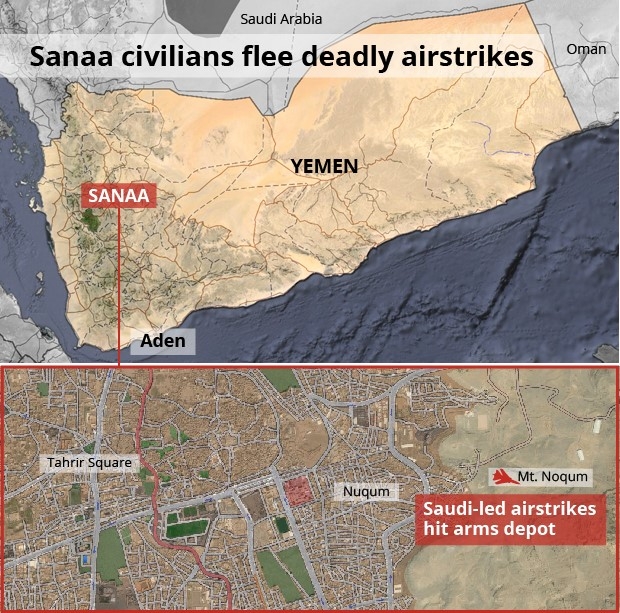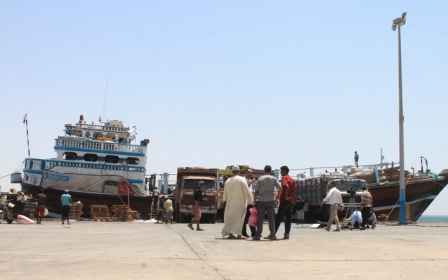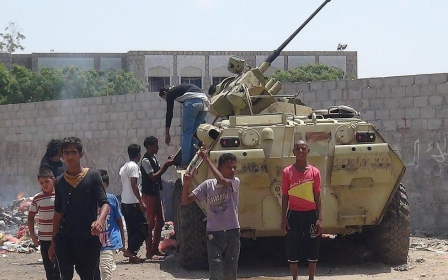Huge airstrike near Sanaa historic district triggers exodus of locals

At least eight civilians were killed, and some 20 wounded on Monday, in explosions sparked by Saudi-led air strikes on rebel arms depots in the Yemeni capital, a medical source said.
The strikes on the Mount Noqum base on the eastern outskirts of Sanaa sent munitions and shrapnel flying into adjacent residential neighbourhoods, witnesses said.
Images from the scene claimed to show smoke rising above the capital from a huge fireball on the slopes of the rocky mountain.
Debris from the explosions fell as far as five kilometres away, triggering an exodus of residents headed for safer areas.
Strikes also targeted the Presidential Palace in central Sanaa.
Final fatality figures are not known, but the strike on Mount Noqum is thought to have caused at least eight casualties.
Local resident Sarah Jamal witnessed the strike from her house in central Sanaa, and said she could hear munitions hidden in the mountain exploding for five hours after the initial impact.
Jamal said that munitions explosions that occur after the initial impact are most feared by local residents.
The mountain borders on the large residential district of Shuub, which is home to up to 150,000 people.
The district, site of one of the ancient gates into the city, is a historic area where houses date back centuries.
Fearing that the stability of these buildings may have been compromised by the latest round of airstrikes, local residents have been attempting to flee to areas of the city further away from strategic sites like mountains and army bases.
However, Jamal warned that few areas are now considered fully secure.
"I'm not sure there is a place that is completely safe. There are anti-aircraft guns on every street - you can protect yourselves from these by staying inside as much as possible. But there is also the danger from exploding munitions."
A previous coalition air raid on the Mount Noqum base on 12 May sparked similar secondary explosions that killed at least 69 civilians and wounded 250.
On 21 April, a raid on a missile base in the rebel-held capital triggered explosions that killed 38 people and wounded 532.
Human Rights Watch said on Sunday that it had documented the use of at least three different types of cluster bombs near civilian areas in Yemen.
Cluster bombs contain dozens of submunitions, which sometimes do not explode immediately, essentially becoming landmines that can kill or maim long after the initial bomb is dropped.
Cluster munitions are prohibited by a 2008 treaty adopted by 116 countries, but not by Saudi Arabia and its coalition partners or the United States.
Though the death toll from the Saudi-led airstrikes has been high, Amnesty International warned last Thursday that residents had blamed anti-aircraft fire for the highest number of casualties.
A doctor at the city’s largest hospital told Amnesty that 90 percent of his patients had been injured by anti-aircraft fire launched by the Houthis in an attempt to ward off airstrikes.
Other airstrikes on Monday hit rebel positions in Amran, north of Sanaa, as well as arms depots in western Hodeidah province, residents said.
Coalition warplanes struck other rebel positions in the southern province of Daleh, military and tribal sources said.
In the rebels' stronghold of Saada, overnight coalition raids struck rebel-held arms depots in the town of Marran, as well as rebel positions in Ibb, farther south in central Yemen, witnesses said.
With airstrikes continuing in Sanaa, Yemenis warned that the situation in other cities was much worse.
The main hospital in the southern city of Aden is no longer functioning, and other health centres are struggling to meet the needs of the local population.
New MEE newsletter: Jerusalem Dispatch
Sign up to get the latest insights and analysis on Israel-Palestine, alongside Turkey Unpacked and other MEE newsletters
Middle East Eye delivers independent and unrivalled coverage and analysis of the Middle East, North Africa and beyond. To learn more about republishing this content and the associated fees, please fill out this form. More about MEE can be found here.





